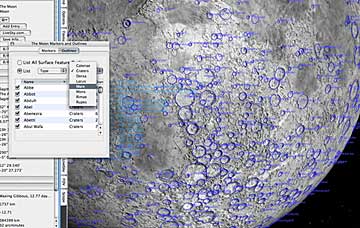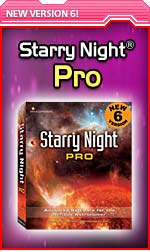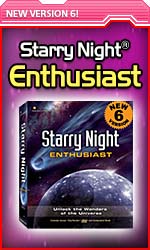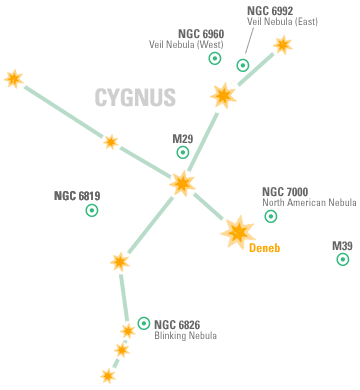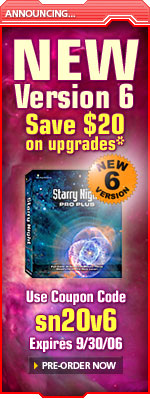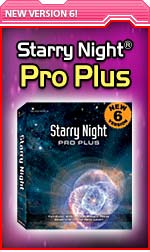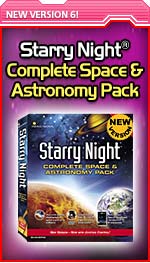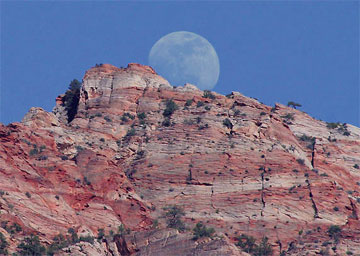 |
||||||||||||||||||||||||||||||||||||||||||||||||||||||||||||||||||||
|
If you have trouble viewing this newsletter, click here. Welcome again to our monthly newsletter with features on exciting celestial events, product reviews, tips & tricks, and a monthly sky calendar. We hope you enjoy it!
Starry Night® 6.0 has arrived with a long list of neat new features. I’ve had a chance to play with it for a couple of weeks, and would like to share with you the things I particularly like about this new version. By
way
of
background,
I’ve
been
an
amateur
astronomer
for
decades,
and
a
Starry
Night®
user
since
version
2.1
in
1999.
I’m
a
very
active
visual
observer,
interested
in
every
sort
of
object
I
can
see
in
the
sky:
Sun,
Moon,
planets,
asteroids,
comets,
double
stars,
variable
stars,
and
deep
sky
objects.
I
have
been
a
user
of
Starry
Night®
on
a
daily
basis
for
the
last
7
years,
both
to
plan
my
own
observations
and
to
help
others.
When
I
started
to
work
for
Starry
Night®
last
year,
I
discovered
all
kinds
of
things
in
the
program
which
I’d
never
seen
or
used,
despite
heavy
use.
Like
any
powerful
piece
of
software,
Starry
Night®
is
many-faceted
and
serves
different
functions
for
different
users.
Event Finder and Reminder The first thing I noticed when I first started up 6.0 was the Daily Event Reminder, literally in my face. This alerts you to events happening today. It proved its value that very first day. In the evening I had some friends over to observe, and I knew that Ganymede’s shadow was in transit across the face of Jupiter because Starry Night® had told me so that morning. To read the rest of this article, click here.
Pronunciation
Guide Some astronomical names can be a little difficult to pronounce. For example, the constellation Boötes is pronounced “boo-OH-tees” not “Boots” or “Booties”. In some cases careful pronunciation may be necessary to avoid embarrassment as in the case of Uranus, which is pronounced “Yoor-a-nus”, not “Your-anus”. The pronunciation guide in Starry Night® will help you learn how to correctly pronounce the names of hundreds of celestial objects from different categories such as stars, constellations and planets. You hear the proper pronunciation of the object’s name through your computer speakers. To pronounce an object's name, right click (Ctrl-click on the Mac) and select Pronounce from the object’s contextual menu. The Pronounce menu item will only be visible if a pronunciation file for the selected object exists in Starry Night®. An object’s name can also be pronounced in the "General Layer" of the Info pane by selecting Show Info from the objects contextual menu. The Starry Night® pronunciation guide is a handy reference to help you win some friendly arguments at your next astronomical gathering. Note: The correct pronunciation of names (even those with historical and mythological roots) can always be debatable. For a QuickTime video demonstrating this new feature, please click here.
Moon
Surface
Feature
Outlines
Turn on the outlines of craters, mountains, valleys and other prominent features on the moon’s surface to help you instantly recognize hundreds of geological features of interest. Note: Surface feature outlines are only available for the Moon. However, location markers are available for Mercury, Venus, Mars and Earth. Starry Night® allows you to search for and identify thousands of predefined locations and features on the surface of the Earth or any other rocky planet or moon where surface data is available. For example, you can zoom in on the Moon and flag all of the Apollo Moon landing sites or display the location of all the astronomical observatories on Earth. To read the rest of this article, click here.
NGC 6960 & NGC 6992, the West and East Veil Nebulas, are part of the Cygnus loop, the remains of a supernova that exploded over 100,000 years ago. Two other sections, NGC 6995 and 6979 are close by. M29 is an unimpressive open cluster, notable only in that it was one of the original discoveries of Charles Messier. NGC 6819 is a small open cluster with about two dozen stars from 10th to 12th magnitude within a 5' circle. Its discovery in 1784 is attributed to Caroline Herschel. Deneb, which marks the tail of the swan, is one of the 20 brightest stars in the night sky. Just three degrees away lies NGC 7000, the North American Nebula, so-called because of its obvious shape. This is an active star forming region and quite large, though it's difficult to see without the aid of astrophotography. M39 is an open cluster, and is a nice binocular object with 30 or so stars spread over its seven lightyear diameter. It's also "pretty close" to Earth, at "just" 800 lightyears. Finally, NCG 6826, the Blinking Nebula, gets its name from an odd phenomenon: its central star appears to blink on and off when you look toward and away from it quickly. Sean
O'Dwyer
|
Sept. 2006
|
|||||||||||||||||||||||||||||||||||||||||||||||||||||||||||||||||||
|
Bridge Mountain Moon This month’s winning photo, taken by Michel Hersen, shows the moon rising over Bridge Mountain in Zion National Park. Canon EOS Digital Camera with a Sigma Zoom Lens using an ISO of 800 and an exposure of 1/1600th second. PHOTO OF THE MONTH COMPETITION: We would like to invite all Starry Night® users to send their quality astronomy photographs to be considered for use in our monthly newsletter. Featured submissions (best of month) will receive a prize of $25 USD. Please read the following guidelines and see the submission e-mail address below.
|
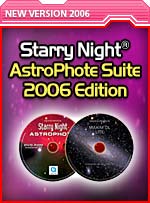 |
|||||||||||||||||||||||||||||||||||||||||||||||||||||||||||||||||||
 |
||||||||||||||||||||||||||||||||||||||||||||||||||||||||||||||||||||
|
*Save $20 off Version 6 Upgrades! To redeem your $20 instant savings on your Starry Night® Enthusiast version 6 upgrade, Pro version 6 upgrade, Pro Plus version 6 upgrade or AstroPhoto Suite (2006 edition) upgrade, you must enter coupon code sn20v6 in the coupon code field of the Starry Night® shopping cart (the coupon code field appears on the Payment Page of the shopping cart. ) The discounted price will only appear in the Starry Night® shopping cart but not on the product detail page. Minimum purchase of $45.00 USD is required. Offer expires September 30, 2006 11:59 pm EST. Not valid on previous purchases. **Pre-order Starry Night® Version 6 by August 22, 2006 for a Free Planisphere! To receive your FREE Orion Star Target Constellation and Celestial Object Finder with your pre-order of Starry Night® Complete Space and Astronomy Pack (2006 edition), Starry Night® Enthusiast version 6, Starry Night Pro version 6, Starry Night® Pro Plus version 6 or AstroPhoto Suite (2006 edition), YOU MUST ADD the FREE Orion Star Target Constellation and Celestial Object Finder from the "May we also suggest" section of your shopping cart before Checkout. Offer expires August 22, 2006 11:59 pm EST. All prices are quoted in USD. ©
1999-2006
Imaginova
Corp.
All
Rights
Reserved. |
||||||||||||||||||||||||||||||||||||||||||||||||||||||||||||||||||||
You
have
received
this
e-mail
as
a
trial
user
of
Starry
Night®
Digital
Download
or
as
a
registrant
at
starrynight.com.
To
unsubscribe,
click
here.
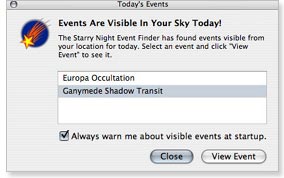 For
now,
I’m
going
to
concentrate
on
the
new
features
which
I’m
particularly
excited
about,
the
ones
that
impact
my
own
observing.
For
now,
I’m
going
to
concentrate
on
the
new
features
which
I’m
particularly
excited
about,
the
ones
that
impact
my
own
observing.